tyre pressure TATA SAFARI 2015 Owners Manual
[x] Cancel search | Manufacturer: TATA, Model Year: 2015, Model line: SAFARI, Model: TATA SAFARI 2015Pages: 161, PDF Size: 2.55 MB
Page 71 of 161
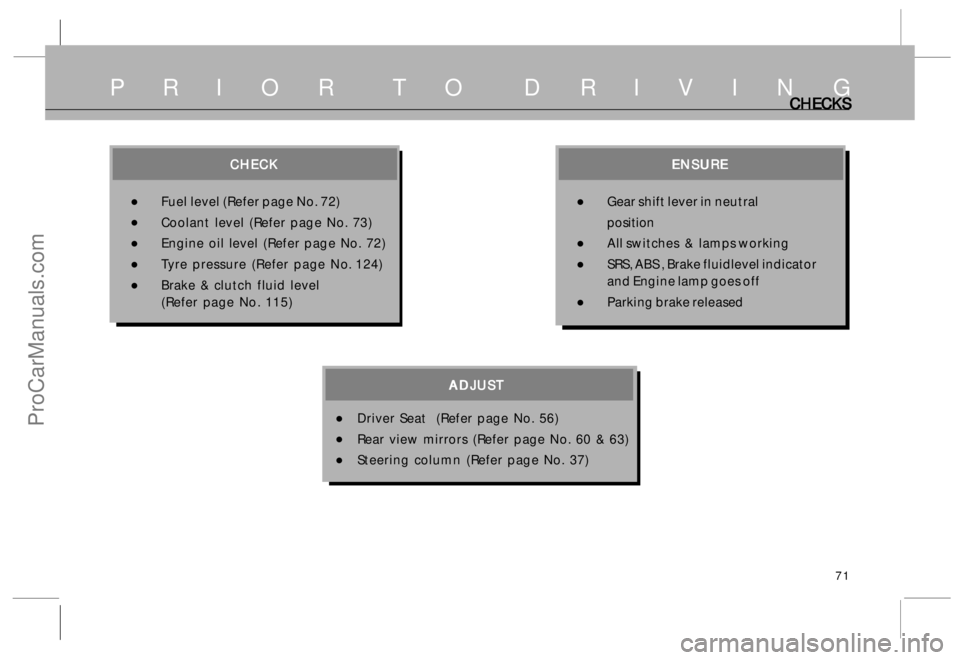
71
P R I O R T O D R I V I N GCHECKS CHECKSCHECKS CHECKS
CHECKS
CHECK CHECKCHECK CHECK
CHECK
•Fuel level (Refer page No. 72)
•Coolant level (Refer page No. 73)
•Engine oil level (Refer page No. 72)
•Tyre pressure (Refer page No. 124)
•Brake & clutch fluid level
(Refer page No. 115)
ENSURE ENSUREENSURE ENSURE
ENSURE
•Gear shift lever in neutral
position
•All switches & lamps working
•SRS, ABS , Brake fluidlevel indicator
and Engine lamp goes off
•Parking brake released
ADJUST ADJUSTADJUST ADJUST
ADJUST
•Driver Seat (Refer page No. 56)
•Rear view mirrors (Refer page No. 60 & 63)
•Steering column (Refer page No. 37)
ProCarManuals.com
Page 80 of 161
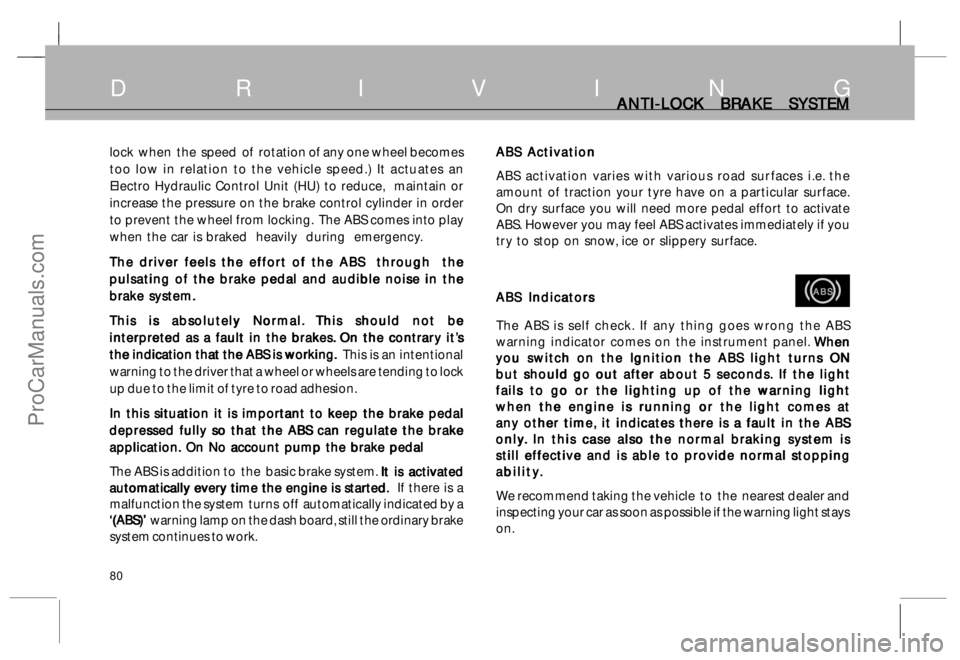
80
D R I V I N GANTI-LOCK BRAKE SYSTEM ANTI-LOCK BRAKE SYSTEMANTI-LOCK BRAKE SYSTEM ANTI-LOCK BRAKE SYSTEM
ANTI-LOCK BRAKE SYSTEM
lock when the speed of rotation of any one wheel becomes
too low in relation to the vehicle speed.) It actuates
an
Electro Hydraulic Control Unit (HU) to reduce, maintain or
increase the pressure on the brake control cylinder in order
to prevent the wheel from locking. The ABS comes into play
when the car is braked heavily during emergency.
The driver feels the effort of the ABS through the The driver feels the effort of the ABS through theThe driver feels the effort of the ABS through the The driver feels the effort of the ABS through the
The driver feels the effort of the ABS through the
pulsating of the brake pedal and audible noise in the pulsating of the brake pedal and audible noise in thepulsating of the brake pedal and audible noise in the pulsating of the brake pedal and audible noise in the
pulsating of the brake pedal and audible noise in the
brake system. brake system.brake system. brake system.
brake system.
T TT T
T
his is absolut his is absoluthis is absolut his is absolut
his is absolut
ely N ely Nely N ely N
ely N
or oror or
or
mal. mal.mal. mal.
mal.
T TT T
T
his should not b his should not bhis should not b his should not b
his should not b
e ee e
e
in inin in
in
t tt t
t
er erer er
er
pr prpr pr
pr
et etet et
et
ed as a fault in the br ed as a fault in the bred as a fault in the br ed as a fault in the br
ed as a fault in the br
ak akak ak
ak
es eses es
es
.. ..
.
On the c On the c On the c On the c
On the c
on onon on
on
tr trtr tr
tr
ar arar ar
ar
y it y ity it y it
y it
’’ ’’
’
s ss s
s
the indic the indicthe indic the indic
the indic
a aa a
a
tion tha tion thation tha tion tha
tion tha
t the ABS is w t the ABS is wt the ABS is w t the ABS is w
t the ABS is w
or oror or
or
k kk k
k
ing inging ing
ing
.. ..
. This is an intentional
warning to the driver that a wheel or wheels are tending to lock
up due to the limit of tyre to road adhesion.
In this situation it is important to keep the brake pedal In this situation it is important to keep the brake pedalIn this situation it is important to keep the brake pedal In this situation it is important to keep the brake pedal
In this situation it is important to keep the brake pedal
depressed fully so that the ABS can regulate the brake depressed fully so that the ABS can regulate the brakedepressed fully so that the ABS can regulate the brake depressed fully so that the ABS can regulate the brake
depressed fully so that the ABS can regulate the brake
application. On No account pump the brake pedal application. On No account pump the brake pedalapplication. On No account pump the brake pedal application. On No account pump the brake pedal
application. On No account pump the brake pedal
The ABS is addition to the basic brake system.
It is activated It is activated It is activated It is activated
It is activated
automatically every time the engine is started. automatically every time the engine is started. automatically every time the engine is started. automatically every time the engine is started.
automatically every time the engine is started. If there is a
malfunction the system turns off automatically indicated by a
‘(ABS)’ ‘(ABS)’ ‘(ABS)’ ‘(ABS)’
‘(ABS)’ warning lamp on the dash board, still the ordinary brake
system continues to work.ABS Activation ABS ActivationABS Activation ABS Activation
ABS Activation
ABS activation varies with various road surfaces i.e. the
amount of traction your tyre have on a particular surface.
On dry surface you will need more pedal effort to activate
ABS. However you may feel ABS activates immediately if you
try to stop on snow, ice or slippery surface.
ABS Indicators ABS IndicatorsABS Indicators ABS Indicators
ABS Indicators
The ABS is self check. If any thing goes wrong the ABS
warning indicator comes on the instrument panel.
W WW W
W
hen henhen hen
hen
you switch on the Ignition the ABS light turns ON you switch on the Ignition the ABS light turns ONyou switch on the Ignition the ABS light turns ON you switch on the Ignition the ABS light turns ON
you switch on the Ignition the ABS light turns ON
but should go out after about 5 seconds. but should go out after about 5 seconds.but should go out after about 5 seconds. but should go out after about 5 seconds.
but should go out after about 5 seconds.
If the light If the lightIf the light If the light
If the light
fails to go or the lighting up of the warning light fails to go or the lighting up of the warning lightfails to go or the lighting up of the warning light fails to go or the lighting up of the warning light
fails to go or the lighting up of the warning light
when the engine is running or the light comes at when the engine is running or the light comes atwhen the engine is running or the light comes at when the engine is running or the light comes at
when the engine is running or the light comes at
any other time, it indicates there is a fault in the ABS any other time, it indicates there is a fault in the ABSany other time, it indicates there is a fault in the ABS any other time, it indicates there is a fault in the ABS
any other time, it indicates there is a fault in the ABS
only onlyonly only
only
.. ..
.
In this c In this c In this c In this c
In this c
ase also the nor ase also the norase also the nor ase also the nor
ase also the nor
mal br mal brmal br mal br
mal br
ak akak ak
ak
ing sy ing sying sy ing sy
ing sy
st stst
st
st
em is em isem is em is
em is
still effective and is able to provide normal stopping still effective and is able to provide normal stoppingstill effective and is able to provide normal stopping still effective and is able to provide normal stopping
still effective and is able to provide normal stopping
abilit abilitabilit abilit
abilit
y yy y
y
.. ..
.
We recommend taking the vehicle to the nearest dealer and
inspecting your car as soon as possible if the warning light stays
on.
ABS ABSABS ABS
ABS
ProCarManuals.com
Page 81 of 161

81
D R I V I N GANTI LOCK BRAKING SYSTEM ANTI LOCK BRAKING SYSTEMANTI LOCK BRAKING SYSTEM ANTI LOCK BRAKING SYSTEM
ANTI LOCK BRAKING SYSTEM
Electronic Brake Distribution (EBD) Electronic Brake Distribution (EBD)Electronic Brake Distribution (EBD) Electronic Brake Distribution (EBD)
Electronic Brake Distribution (EBD)
indicator indicatorindicator indicator
indicator
If the ABS and the brake system indicator light comes If the ABS and the brake system indicator light comesIf the ABS and the brake system indicator light comes If the ABS and the brake system indicator light comes
If the ABS and the brake system indicator light comes
together even after the parking brake is fully released, together even after the parking brake is fully released,together even after the parking brake is fully released, together even after the parking brake is fully released,
together even after the parking brake is fully released,
then the Electronic Brake Distribution (EBD) i.e. the then the Electronic Brake Distribution (EBD) i.e. thethen the Electronic Brake Distribution (EBD) i.e. the then the Electronic Brake Distribution (EBD) i.e. the
then the Electronic Brake Distribution (EBD) i.e. the
front to rear brake force distribution system is also not front to rear brake force distribution system is also notfront to rear brake force distribution system is also not front to rear brake force distribution system is also not
front to rear brake force distribution system is also not
w ww w
w
or oror or
or
k kk k
k
in inin in
ing. This will lead to the rear wheel lock while braking.
Avoid sudden hard braking and take the car immediately to
the nearest dealer to fix the system.
Safety tips while driving with ABS Safety tips while driving with ABSSafety tips while driving with ABS Safety tips while driving with ABS
Safety tips while driving with ABS
1) During a hard braking or when the road grip is poor, you
will feel the brake pedal is pulsating and an audible noise
in the system. This is absolutely Normal and it’s the
indication that your ABS is rapidly pumping the brakes. Do
not release the brake pedal, this defeats the purpose of
ABS. Keep firm steady pressure on the brake pedal so as
not to interrupt the braking action as long as you steer
away from the hazard.
2) 2)2) 2)
2)
ABS prevents the wheel from locking but it does not ABS prevents the wheel from locking but it does notABS prevents the wheel from locking but it does not ABS prevents the wheel from locking but it does not
ABS prevents the wheel from locking but it does not
increase actual tyre to road grip. increase actual tyre to road grip. increase actual tyre to road grip. increase actual tyre to road grip.
increase actual tyre to road grip. Hence even if
your car is fitted with ABS, maintain a safe followingdistance.
3) 3)3) 3)
3)
ABS does not reduce either time or stopping ABS does not reduce either time or stoppingABS does not reduce either time or stopping ABS does not reduce either time or stopping
ABS does not reduce either time or stopping
distanc distancdistanc distanc
distanc
e ee e
e, It only helps steering control during braking. You
should always keep a safe distance from other vehicles.
4) 4)4)
4)
4)
ABS will not prevent skidding of a car that results ABS will not prevent skidding of a car that resultsABS will not prevent skidding of a car that results ABS will not prevent skidding of a car that results
ABS will not prevent skidding of a car that results
from changing direction abruptly from changing direction abruptly from changing direction abruptly from changing direction abruptly
from changing direction abruptly such as trying to
take a corner too fast or making a sudden lane change.
5) 5)5) 5)
5)
ABS cannot prevent a loss of stability due to severe ABS cannot prevent a loss of stability due to severeABS cannot prevent a loss of stability due to severe ABS cannot prevent a loss of stability due to severe
ABS cannot prevent a loss of stability due to severe
or sharp steering wheel movement. or sharp steering wheel movement.or sharp steering wheel movement. or sharp steering wheel movement.
or sharp steering wheel movement. Always steer
moderately while braking hard.
6) 6)6) 6)
6)
ABS requires a little longer stopping distance than ABS requires a little longer stopping distance thanABS requires a little longer stopping distance than ABS requires a little longer stopping distance than
ABS requires a little longer stopping distance than
a vehicle with conventional brake system on a loose a vehicle with conventional brake system on a loosea vehicle with conventional brake system on a loose a vehicle with conventional brake system on a loose
a vehicle with conventional brake system on a loose
or une or uneor une or une
or une
v vv v
v
en sur en suren sur en sur
en sur
fac facfac fac
fac
e ee e
e
,, ,,
, such as gravel or snow. Slow down
and allow a safe following distance.
7) 7)7) 7)
7)
ABS ABSABS ABS
ABS
serves to increase your control over the car not serves to increase your control over the car not serves to increase your control over the car not serves to increase your control over the car not
serves to increase your control over the car not
t tt t
t
o enable y o enable yo enable y o enable y
o enable y
ou t ou tou t ou t
ou t
o go fast o go fasto go fast o go fast
o go fast
er erer er
er
.. ..
.
ABS ABSABS ABS
ABS
ProCarManuals.com
Page 85 of 161

85
D R I V I N GDRIVING IN ADVERSE CONDITIONS DRIVING IN ADVERSE CONDITIONSDRIVING IN ADVERSE CONDITIONS DRIVING IN ADVERSE CONDITIONS
DRIVING IN ADVERSE CONDITIONS
Driving on Snowy or Icy Roads Driving on Snowy or Icy RoadsDriving on Snowy or Icy Roads Driving on Snowy or Icy Roads
Driving on Snowy or Icy Roads
Set the selector knob to 4H position. Gently release the clutch
and apply the accelerator for a smooth start and to avoid wheel
spin.
CAUTION CAUTIONCAUTION CAUTION
CAUTION
Use of snow tyres and / or tyre chain is recommended.
Maintain a safe distance between vehicles to avoid sudden
braking and slow down by shifting down the gears.
Avoid sudden acceleration, braking or turning. Such sharp
manoeuvers can cause loss of traction and thereby loss of vehicle
control.
Driving on Sandy or Muddy Roads Driving on Sandy or Muddy RoadsDriving on Sandy or Muddy Roads Driving on Sandy or Muddy Roads
Driving on Sandy or Muddy Roads
In case the traction on the wheels is sufficient, you may be
able to proceed in 4H mode. However in case change in
road conditions are anticipated, it is better to select the 4L
mode. Shift the selector knob to 4L position by following
the correct procedure and proceed in the normal manner.
Your vehicle will move at a slower pace with higher engine
RPM in the same gear because of the 4L mode. To match
your power and speed requirements, you can shift up in
any of the 5 forward gears or the reverse gear.NOTICE NOTICENOTICE NOTICE
NOTICE
You may choose to reduce the tyre pressure marginally for
additional grip on loose surfaces, though with a slight loss of
ground clearance.
•Try to maintain a constant engine speed and avoid sudden
acceleration which can cause wheel spin and loss of traction,
possibly leading to bogging down of the vehicle.
•If the vehicle gets stuck in loose sand, do not keep on
accelerating as the wheel spin will only result in the
wheels sinking deeper.
•The extent of muddy / sandy, conditions and the traction
available is difficult to judge and the vehicle can get
bogged down deeply. Operation should be done at slow
speed only. If possible, get down and check the path
conditions before proceeding.
ProCarManuals.com
Page 86 of 161
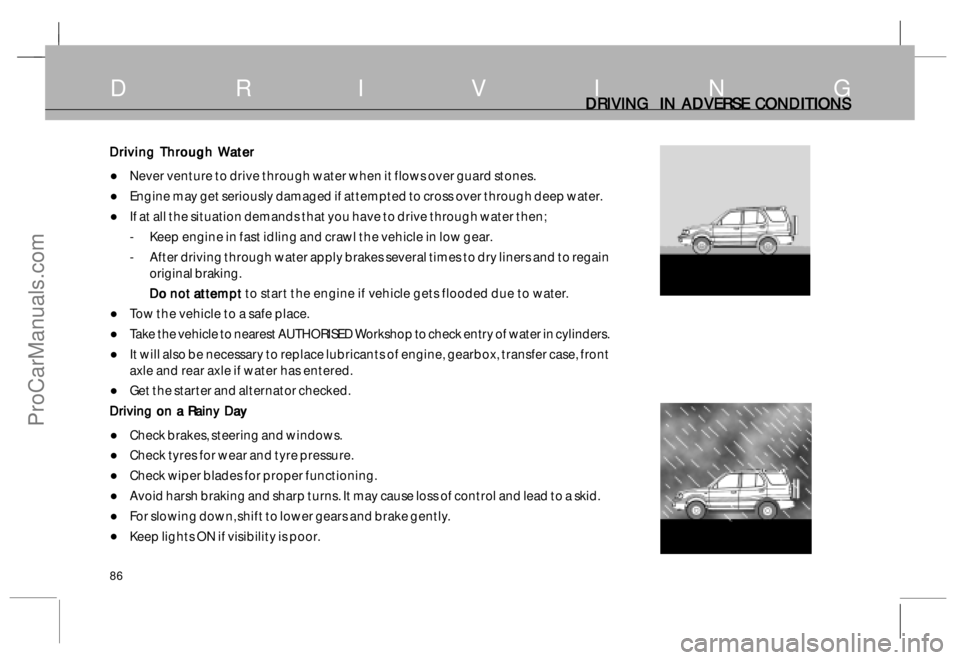
86
D R I V I N GDRIVING IN ADVERSE CONDITIONS DRIVING IN ADVERSE CONDITIONSDRIVING IN ADVERSE CONDITIONS DRIVING IN ADVERSE CONDITIONS
DRIVING IN ADVERSE CONDITIONS
Driving Through Water Driving Through WaterDriving Through Water Driving Through Water
Driving Through Water
•Never venture to drive through water when it flows over guard stones.
•Engine may get seriously damaged if attempted to cross over through deep water.
•If at all the situation demands that you have to drive through water then;
- Keep engine in fast idling and crawl the vehicle in low gear.
- After driving through water apply brakes several times to dry liners and to regain
original braking.
D DD D
D
o not a o not ao not a o not a
o not a
tt tttt tt
tt
empt emptempt empt
empt to start the engine if vehicle gets flooded due to water.
•Tow the vehicle to a safe place.
•Take the vehicle to nearest AUTHORISED Workshop to check entry of water in cylinders.
•It will also be necessary to replace lubricants of engine, gearbox, transfer case, front
axle and rear axle if water has entered.
•Get the starter and alternator checked.
Driving on a Rainy Day Driving on a Rainy DayDriving on a Rainy Day Driving on a Rainy Day
Driving on a Rainy Day
•Check brakes, steering and windows.
•Check tyres for wear and tyre pressure.
•Check wiper blades for proper functioning.
•Avoid harsh braking and sharp turns. It may cause loss of control and lead to a skid.
•For slowing down, shift to lower gears and brake gently.
•Keep lights ON if visibility is poor.
ProCarManuals.com
Page 90 of 161
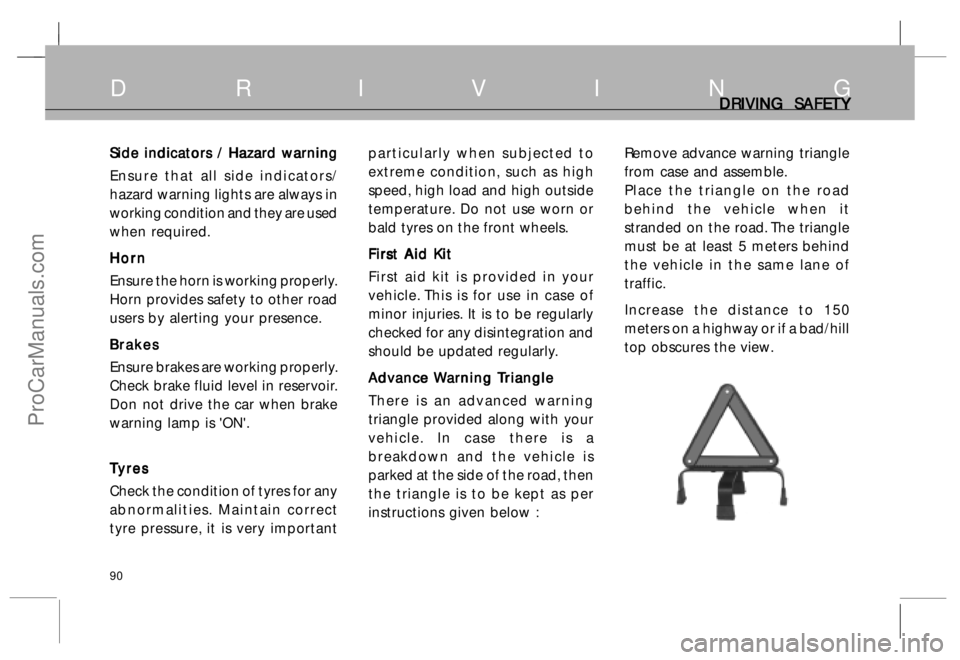
90
D R I V I N GDRIVING SAFET DRIVING SAFETDRIVING SAFET DRIVING SAFET
DRIVING SAFET
Y YY Y
Y
Side indicators / Hazard warning Side indicators / Hazard warningSide indicators / Hazard warning Side indicators / Hazard warning
Side indicators / Hazard warning
Ensure that all side indicators/
hazard warning lights are always in
working condition and they are used
when required.
Horn HornHorn Horn
Horn
Ensure the horn is working properly.
Horn provides safety to other road
users by alerting your presence.
Brakes BrakesBrakes Brakes
Brakes
Ensure brakes are working properly.
Check brake fluid level in reservoir.
Don not drive the car when brake
warning lamp is 'ON'.
T TT T
T
yr yryr yr
yr
es eses es
es
Check the condition of tyres for any
abnormalities. Maintain correct
tyre pressure, it is very importantparticularly when subjected to
extreme condition, such as high
speed, high load and high outside
temperature. Do not use worn or
bald tyres on the front wheels.
First Aid Kit First Aid KitFirst Aid Kit First Aid Kit
First Aid Kit
First aid kit is provided in your
vehicle. This is for use in case of
minor injuries. It is to be regularly
checked for any disintegration and
should be updated regularly.
A AA A
A
d dd d
d
v vv v
v
anc ancanc anc
anc
e e e e
e
W WW W
W
ar arar ar
ar
ning ning ning ning
ning
T TT T
T
r rr r
r
iangle iangleiangle iangle
iangle
There is an advanced warning
triangle provided along with your
vehicle. In case there is a
breakdown and the vehicle is
parked at the side of the road, then
the triangle is to be kept as per
instructions given below :Remove advance warning triangle
from case and assemble.
Place the triangle on the road
behind the vehicle when it
stranded on the road. The triangle
must be at least 5 meters behind
the vehicle in the same lane of
traffic.
Increase the distance to 150
meters on a highway or if a bad/hill
top obscures the view.
ProCarManuals.com
Page 122 of 161
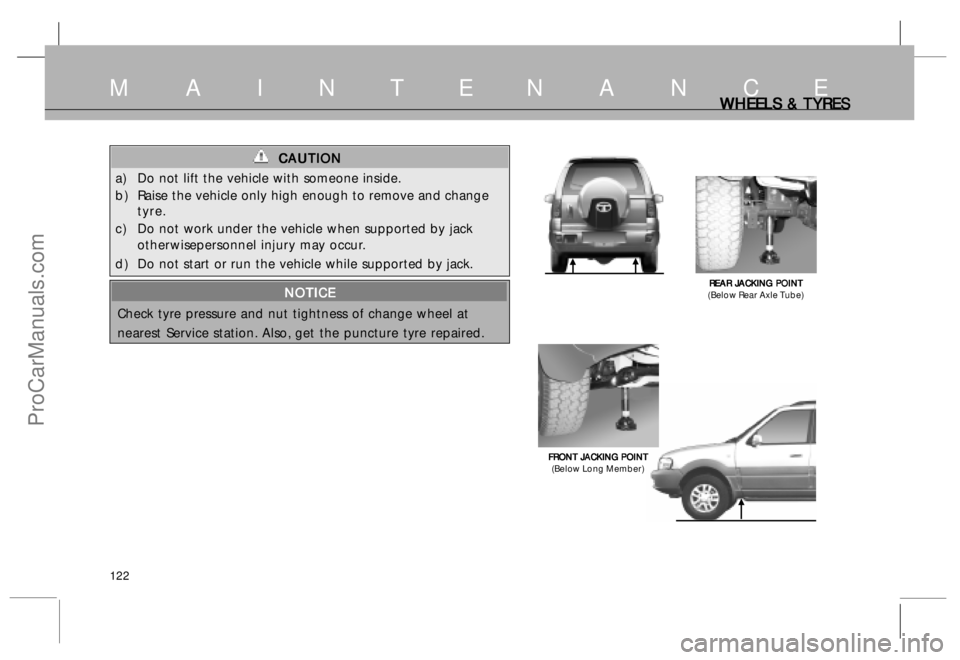
122
M A I N T E N A N C EWHEELS & WHEELS & WHEELS & WHEELS &
WHEELS &
T TT T
T
YRES YRESYRES YRES
YRES
REAR JACKING POINT REAR JACKING POINTREAR JACKING POINT REAR JACKING POINT
REAR JACKING POINT
(Below Rear Axle Tube)
FRONT JACKING POINT FRONT JACKING POINTFRONT JACKING POINT FRONT JACKING POINT
FRONT JACKING POINT
(Below Long Member)
CAUTION CAUTIONCAUTION CAUTION
CAUTION
a) Do not lift the vehicle with someone inside.
b) Raise the vehicle only high enough to remove and change
tyre.
c) Do not work under the vehicle when supported by jack
otherwisepersonnel injury may occur.
d ) Do not start or run the vehicle while supported by jack.
NOTICE NOTICENOTICE NOTICE
NOTICE
Check tyre pressure and nut tightness of change wheel at
nearest Service station. Also, get the puncture tyre repaired.
ProCarManuals.com
Page 123 of 161
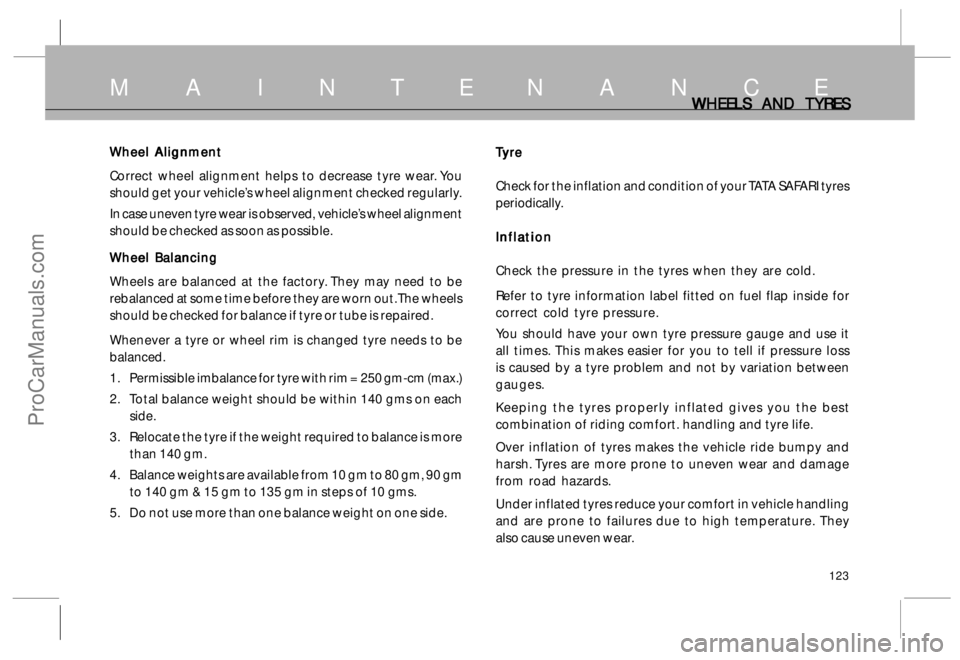
123
WHEELS AND WHEELS AND WHEELS AND WHEELS AND
WHEELS AND
T TT T
T
YRES YRESYRES YRES
YRES
Wheel Alignment Wheel AlignmentWheel Alignment Wheel Alignment
Wheel Alignment
Correct wheel alignment helps to decrease tyre wear. You
should get your vehicle’s wheel alignment checked regularly.
In case uneven tyre wear is observed, vehicle’s wheel alignment
should be checked as soon as possible.
Wheel Balancing Wheel BalancingWheel Balancing Wheel Balancing
Wheel Balancing
Wheels are balanced at the factory. They may need to be
rebalanced at some time before they are worn out. The wheels
should be checked for balance if tyre or tube is repaired.
Whenever a tyre or wheel rim is changed tyre needs to be
balanced.
1. Permissible imbalance for tyre with rim = 250 gm-cm (max.)
2. Total balance weight should be within 140 gms on each
side.
3. Relocate the tyre if the weight required to balance is more
than 140 gm.
4. Balance weights are available from 10 gm to 80 gm, 90 gm
to 140 gm & 15 gm to 135 gm in steps of 10 gms.
5. Do not use more than one balance weight on one side.T TT T
T
yr yryr yr
yr
e ee e
e
Check for the inflation and condition of your TATA SAFARI tyres
periodically.
Inflation InflationInflation Inflation
Inflation
Check the pressure in the tyres when they are cold.
Refer to tyre information label fitted on fuel flap inside for
correct cold tyre pressure.
You should have your own tyre pressure gauge and use it
all times. This makes easier for you to tell if pressure loss
is caused by a tyre problem and not by variation between
gauges.
Keeping the tyres properly inflated gives you the best
combination of riding comfort. handling and tyre life.
Over inflation of tyres makes the vehicle ride bumpy and
harsh. Tyres are more prone to uneven wear and damage
from road hazards.
Under inflated tyres reduce your comfort in vehicle handling
and are prone to failures due to high temperature. They
also cause uneven wear.
M A I N T E N A N C E
ProCarManuals.com
Page 124 of 161
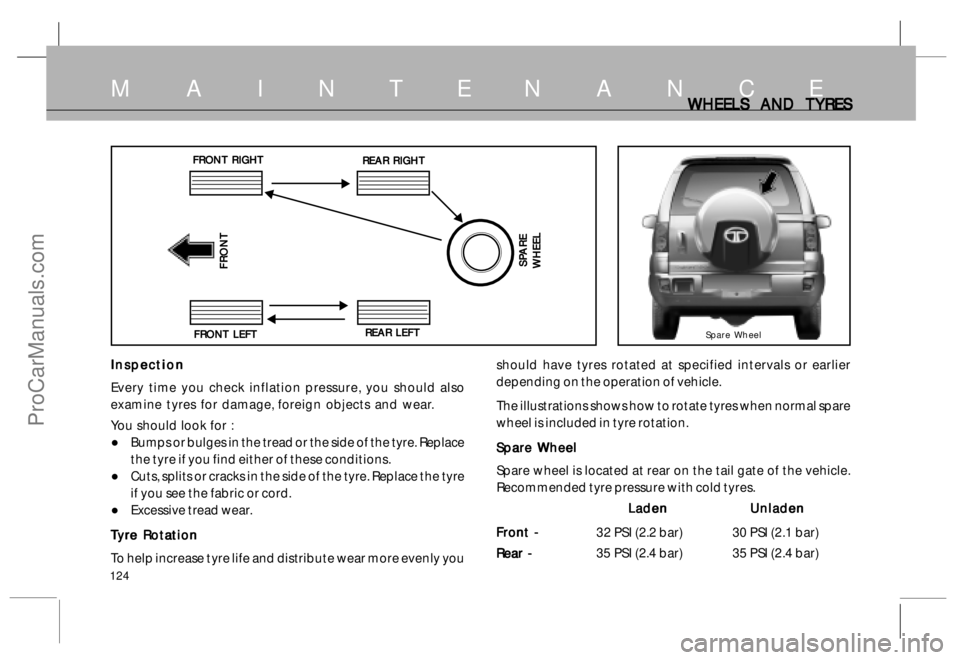
124
Inspection InspectionInspection Inspection
Inspection
Every time you check inflation pressure, you should also
examine tyres for damage, foreign objects and wear.
You should look for :
•Bumps or bulges in the tread or the side of the tyre. Replace
the tyre if you find either of these conditions.
•Cuts, splits or cracks in the side of the tyre. Replace the tyre
if you see the fabric or cord.
•Excessive tread wear.
T TT T
T
yr yryr yr
yr
e R e Re R e R
e R
ota otaota ota
ota
tion tiontion tion
tion
To help increase tyre life and distribute wear more evenly you
WHEELS AND WHEELS AND WHEELS AND WHEELS AND
WHEELS AND
T TT T
T
YRES YRESYRES YRES
YRESM A I N T E N A N C E
should have tyres rotated at specified intervals or earlier
depending on the operation of vehicle.
The illustrations shows how to rotate tyres when normal spare
wheel is included in tyre rotation.
Spare Wheel Spare WheelSpare Wheel Spare Wheel
Spare Wheel
Spare wheel is located at rear on the tail gate of the vehicle.
Recommended tyre pressure with cold tyres.
Laden LadenLaden Laden
Laden
Unladen UnladenUnladen Unladen
Unladen
Front - Front -Front - Front -
Front - 32 PSI (2.2 bar) 30 PSI (2.1 bar)
Rear - Rear -Rear - Rear -
Rear - 35 PSI (2.4 bar) 35 PSI (2.4 bar)
Spare Wheel
FRONT FRONTFRONT FRONT
FRONT
FRONT LEFT FRONT LEFTFRONT LEFT FRONT LEFT
FRONT LEFTREAR LEFT REAR LEFTREAR LEFT REAR LEFT
REAR LEFT
SP SPSP SP
SP
ARE AREARE ARE
ARE
WHEEL WHEELWHEEL WHEEL
WHEEL
FRONT RIGHT FRONT RIGHTFRONT RIGHT FRONT RIGHT
FRONT RIGHT
REAR RIGHT REAR RIGHTREAR RIGHT REAR RIGHT
REAR RIGHT
ProCarManuals.com
Page 127 of 161

127
Maintaining the car when not in extended use : Maintaining the car when not in extended use :Maintaining the car when not in extended use : Maintaining the car when not in extended use :
Maintaining the car when not in extended use :
Park the car in covered, dry and if possible well-ventilated
premises.
Engage a gear.
Remove the cables from the battery terminals (first remove
the cable from the negative terminal).
Make sure the handbrake is not engaged.
Clean and protect the painted parts using protective wax.
Clean and protect the shiny metal parts using commercially
available special compounds.
Sprinkle talcum powder on the rubber windscreen wiper and
rear window wiper blades and lift them off the glass.
Slightly open the windows.
Cover the car with a cloth or perforated plastic sheet. Do
not use sheets of imperforated plastic as they do not allow
moisture on the car body to evaporate.
Inflate the tyres to 0.5 bar above the normal specified
pressure and check it at regular intervals.
Check the battery charge every six weeks.
Do not drain the engine cooling system.
VEHICLE C VEHICLE CVEHICLE C VEHICLE C
VEHICLE C
ARE AREARE ARE
ARE
Wiper Care : Wiper Care :Wiper Care : Wiper Care :
Wiper Care :
Wiper blade attack angle on windshield glass should be 90
0
i.e. perpendicular.
Remove wiper blade and root wiper arm on windshield glass
in the centre position. Check the gap between arm strip
and glass.
Adjust by twisting wiper arm as shown in the figure.
OK OKOK OK
OK FOR CHA FOR CHAFOR CHA FOR CHA
FOR CHA
T TT T
T
TERING & NOISY PR TERING & NOISY PRTERING & NOISY PR TERING & NOISY PR
TERING & NOISY PR
OBLEMS OBLEMSOBLEMS OBLEMS
OBLEMS
NO NONO NO
NO
T OK T OKT OK T OK
T OK Windshield
GlassVIE VIEVIE VIE
VIE
W W W W
W
WITHOUT WITHOUT WITHOUT WITHOUT
WITHOUT
WIPER BL WIPER BLWIPER BL WIPER BL
WIPER BL
ADE ADEADE ADE
ADE
M A I N T E N A N C E
ProCarManuals.com